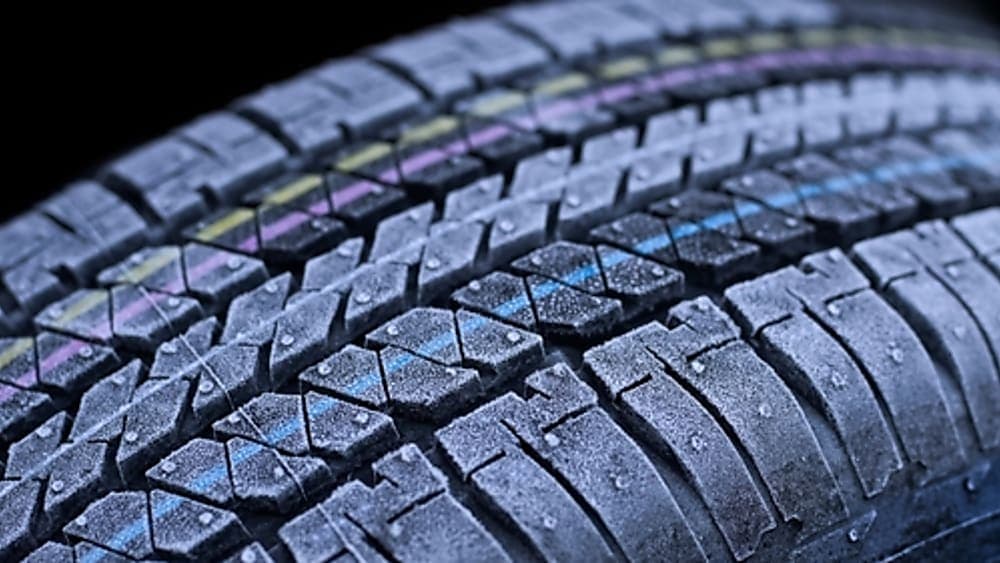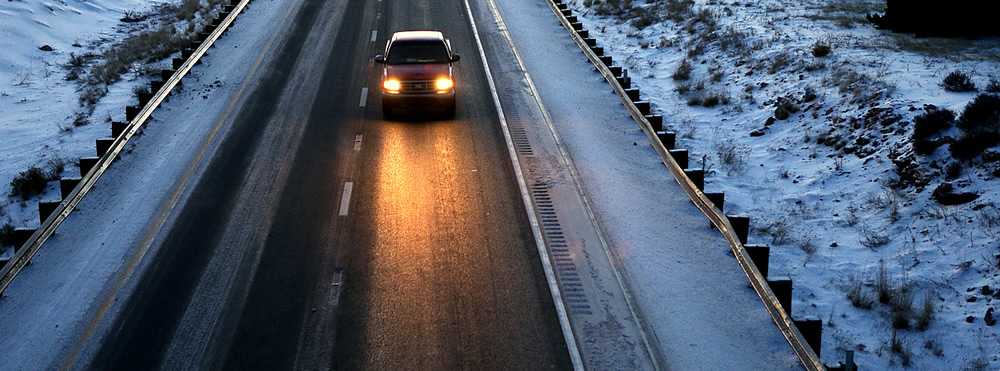Tire maintenance & safety
How to drive on black ice top tips

Free shipping
Best price guarantee
Special pricing
Financing with Resolve
Easy returns
Tire maintenance & safety


Winter roads present unique challenges that demand respect and preparation from every driver. Black ice stands as one of the most dangerous hazards you'll encounter during cold weather months, claiming thousands of accidents each year due to its nearly invisible nature.
The term "black ice" misleads many drivers who expect to see dark patches on the road. This transparent glaze blends seamlessly with pavement surfaces, making detection extremely difficult until your vehicle begins to slide.
Understanding how to navigate black ice safely can mean the difference between arriving at your destination and becoming another winter accident statistic. The following techniques and knowledge will equip you with the tools needed to handle this treacherous road condition with confidence.
Black ice forms when moisture on road surfaces freezes into a thin, transparent sheet that appears identical to dry pavement. This deceptive coating develops through several mechanisms: light freezing rain that instantly glazes the road, melting snow that refreezes as temperatures drop, or even exhaust moisture from vehicles that crystallizes on cold highways. The absence of air bubbles during formation creates its signature transparency—unlike regular ice that appears white or cloudy due to trapped air.
The most dangerous aspect of black ice lies in its perfect camouflage. Drivers often mistake these glossy patches for wet pavement or fail to notice them entirely until their tires lose traction. Black ice typically forms when temperatures hover near the freezing point of 32°F (0°C), though it can develop at slightly higher temperatures when road surfaces remain colder than the surrounding air. Bridges, overpasses, and shaded areas prove particularly susceptible because cold air circulates both above and below these structures, accelerating the freezing process.
Certain conditions create ideal environments for black ice formation:
Navigating icy roads requires a composed demeanor and an understanding of the road's hidden dangers. To effectively drive on black ice, start by identifying areas where it might be present. Keep a watchful eye on the road for any surfaces that appear unusually glossy. These conditions often occur in spots exposed to less sunlight, such as underpasses and roads lined with trees.
Maintaining a manageable speed and extending the space between your car and others are vital strategies. Reducing speed not only helps preserve traction but also allows more time to make necessary adjustments. Keep a safe buffer between your vehicle and others, as icy roads demand longer braking distances. Make gradual adjustments and steer smoothly to avoid destabilizing your vehicle.
In the event of encountering a slide, maintaining composure is key. Should your vehicle begin to skid, gently guide the steering wheel in the direction you're sliding to help regain control. Refrain from slamming the brakes; instead, ease off the accelerator to decelerate steadily. This method reduces the risk of exacerbating the skid, enabling you to manage the vehicle more effectively on icy terrain.
Identifying black ice involves understanding the subtle cues and environmental signs that signal its presence. It often forms when temperatures dip, particularly during the twilight hours when the sun's warmth is absent. Conditions become favorable for black ice when cold weather coincides with moisture on road surfaces, making early mornings and late evenings critical times for heightened awareness.
Detecting black ice requires attentiveness to the road's surface. Watch for areas that seem slicker or smoother compared to the rest of the pavement, as these might conceal a thin layer of ice. On roadways, note any sudden changes in the road's texture or appearance. Elevated stretches such as bridges and overpasses frequently harbor ice earlier than other sections because they cool more rapidly.
Certain road spots demand extra caution due to their propensity for ice accumulation. Areas with overhead coverage, like tunnels, or those adjacent to water bodies, often possess the right conditions for ice to form. Understanding these potential hotspots is crucial for anticipating and managing the risks associated with black ice while driving.
When navigating roads with black ice, it is essential to adjust your driving style by moderating your speed. Traveling at a more cautious pace allows you to adapt to sudden changes in road conditions and maintain better control over your vehicle. By gently easing off the accelerator as you approach areas susceptible to icing, such as overpasses and shadowed curves, you create a safety margin that helps manage potential slides. This careful approach not only supports effective steering but also mitigates the impact of any unexpected skids.
Ensuring a generous distance between your vehicle and the one ahead is vital for safe travel on icy roads. The increased stopping distance required on ice necessitates a wider gap to ensure sufficient reaction time for unexpected situations. By maintaining this buffer, you provide yourself ample space to adjust your driving without abrupt actions. This becomes particularly important when following larger vehicles that may obstruct your view, offering you the opportunity to anticipate traffic changes and respond smoothly.
Avoiding abrupt movements and sharp turns is crucial to preserving stability on slippery roads. Rapid steering inputs can lead to a loss of control, especially on ice, where traction is compromised. Gradual application of the brakes and smooth steering ensure your vehicle's balance remains intact, allowing you to maneuver bends and curves with confidence. This methodical driving style not only enhances safety but also contributes to a more assured journey through winter's icy challenges.
Facing a skid on black ice demands composed and thoughtful actions to reestablish control over your vehicle. The initial response should be to keep a level head, as anxiety can lead to mistakes that worsen the situation. Rather than braking abruptly, concentrate on maintaining a firm yet gentle hold on the steering wheel while executing smooth, controlled movements.
When your vehicle starts to slide, gently adjust your steering to align with the slide's direction. This approach, steering towards the direction the rear of your vehicle is moving, helps the tires regain their grip on the road surface. For instance, if the back of your car slides to the right, guide your steering to the right. This maneuver aids in stabilizing the vehicle, reducing the risk of a complete spin.
While steering, ease your foot off the accelerator to decelerate gradually, allowing the car to slow without sudden shifts. A gentle reduction in speed permits the tires to reestablish traction more effectively. Once stability returns, make measured adjustments to your speed and direction. These careful tactics emphasize the importance of maintaining composure and making deliberate decisions when navigating the challenges of black ice.
Adapting your vehicle's gear selection for icy conditions enhances control and stability. Opting for a lower gear when approaching slick surfaces allows for smoother power delivery, minimizing the risk of wheel slip. This technique proves especially useful on declines or when navigating areas with varying traction, as it helps maintain a consistent speed without the need for sudden braking. Leveraging the engine's power through lower gears contributes to a more controlled drive over unpredictable road conditions.
Ensuring your tires are in optimal condition is crucial for effective traction on winter roads. Tires with sufficient tread depth are better equipped to handle snow and icy patches, as they can channel away moisture and provide a firmer grip on the road. Regular tire checks for adequate tread and overall condition are essential for preventing loss of control in slippery scenarios. Tires that are worn down may not offer the necessary traction, increasing the likelihood of sliding.
For those driving in regions with frequent ice and snow, investing in winter tires provides significant benefits. These tires are designed with unique tread patterns and rubber compounds that maintain flexibility in cold temperatures, thereby enhancing grip on icy and snowy surfaces. Snow tires improve both braking efficiency and cornering stability, essential for safe winter driving. Many drivers find that utilizing specialized winter tires significantly enhances their confidence and vehicle performance in challenging weather conditions.
Being proactive about road conditions is crucial for navigating winter weather safely. Monitor weather forecasts and traffic updates for any signs of black ice, allowing you to adjust your travel plans accordingly. Utilize apps and services that provide live updates on weather patterns and road conditions, giving you real-time information to make informed decisions about your journey. This foresight helps you anticipate driving challenges and adjust your route or timing to avoid hazardous conditions.
Outfitting your vehicle with a comprehensive emergency kit is a key component of winter preparedness. Include necessities such as warm clothing, a flashlight, extra batteries, and non-perishable food items. Additionally, carry tools like an ice scraper, a small shovel, and a bag of sand or kitty litter for traction. These supplies ensure you're equipped to handle unexpected delays or situations where additional traction might be needed, enhancing your safety and readiness on icy roads.
Enhancing your winter driving skills through practice can significantly improve your confidence and capability in challenging conditions. Consider attending a specialized driving course focused on winter safety, where you can practice essential maneuvers such as controlled braking and skid recovery. These courses offer hands-on experience in a safe environment, allowing you to refine your techniques and better prepare for real-world situations on icy roads.
Unexpected encounters with black ice demand a steady and attentive approach. Instead of succumbing to panic, focus on maintaining mental clarity to navigate the situation effectively. Panic reactions, like rapid movements, can worsen the slide and decrease vehicle stability. By consciously slowing your breathing, you can enhance your focus, enabling you to evaluate the road conditions and react calmly.
Directing your attention to a point on the road where you intend to go aids in steering control. This strategy, known as "vision control," helps align your steering inputs with the desired path, facilitating smoother corrections. Visualizing your safe exit path enhances your ability to control the vehicle's direction, ensuring you remain on course despite the slippery conditions.
Consistently reinforcing effective driving techniques equips you to handle icy surprises with greater confidence. Regularly practicing key skills—such as maintaining a steady speed and using light braking—ensures these actions become instinctive when faced with sudden ice patches. Engaging in controlled practice sessions in safe environments strengthens your capability to manage real-life black ice challenges.
Integrating these driving strategies into your routine fortifies your preparedness for unforeseen ice encounters. Understanding how your vehicle reacts on icy surfaces and developing a practiced response to skids provides a strong foundation for safe winter driving. This preparation empowers you to traverse even the most hazardous conditions with assurance, minimizing accident risks and enhancing overall road safety in winter climates.
Mastering these black ice driving techniques transforms winter roads from treacherous obstacles into manageable challenges you can navigate with confidence. Remember that proper tire selection plays a crucial role in maintaining traction during icy conditions, as quality tires with adequate tread depth provide the grip needed to stay safe when temperatures drop. When you're ready to upgrade your vehicle's winter performance, we invite you to shop for tires online and find the best deals that match your driving needs and budget.
Search By